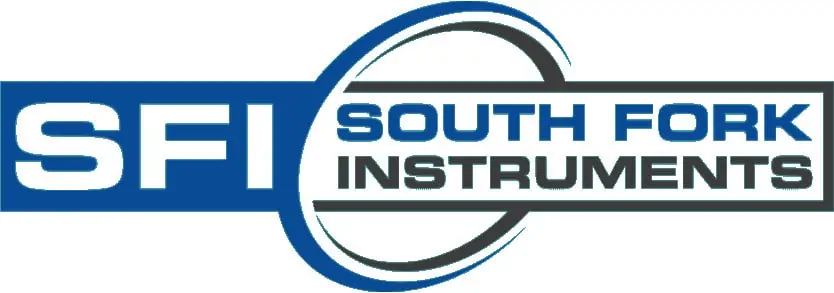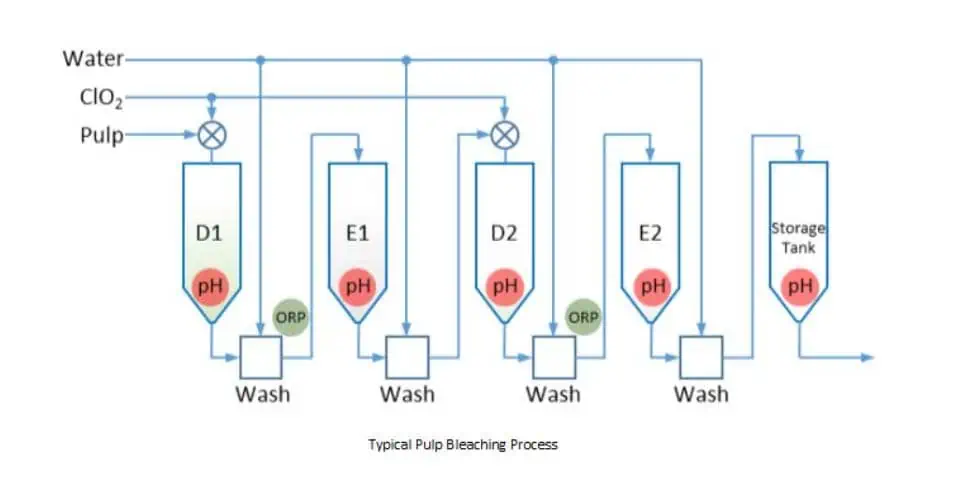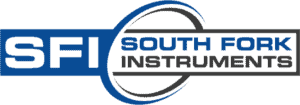Delignification and subsequent bleaching of the wood pulp are integral steps in paper manufacturing. Given its brown color, the lignin must be removed, or it will affect the quality of the final paper product. Although “cooking” removes most of the lignin early in the paper-making process, total elimination by “cooking” alone is impossible without damaging the pulp fibers. Thus, bleaching is necessary to complete the job and maintain product integrity.
Bleaching: A Multistage Process
- The ECF Method
Desired pulp brightness determines how many stages of bleaching are required. Considered more environmentally friendly than previous alternatives, the Elemental Chlorine Free (ECF) method has emerged as the most common approach. This method mixes chlorine dioxide (referred to as the “D” stage) with the pulp in the D tower. The ensuing chemical reaction then selectively targets the lignin without degrading cellulose fibers, allowing for both increased yield and a higher strength bleached pulp.
- Caustic Extraction
Following the initial bleaching in the D tower, the pulp undergoes caustic extraction (the “E” stage). The remaining lignin is dissolved in a high pH environment, typically over 11. Efficient washing of the reacted pulp during the transfer between the D and E towers serves to reclaim chlorine dioxide and minimize acid carryover. This alternating D-E-D-E sequence is commonplace, although it can vary depending on mill-specific requirements and local conditions. - Pulp Stock Preparation
While delignification and bleaching prepare the raw pulp for paper manufacturing, further refinement and processing are needed before it’s ready for paper production. Achieving improvements in fiber binding, strength, smoothness, color, and opacity necessitates both mechanical processing and chemical additives. pH must be carefully controlled throughout these stages for optimal results as it significantly impacts the efficacy of these chemicals. - Refining and Mixing
A typical first stage after basic raw pulp dilution is refining, which shreds and flattens the pulp to improve its bonding characteristics. The pH levels significantly influence the tensile strength of the pulp fibers, with higher pH levels contributing to energy savings during refining. After refining, the pulp moves to a mixing chest, where chemical additives are introduced. Careful pH measurement and maintenance facilitate proper chemical reaction of additives and retention of fillers. - Final Processing and Delivery
From the mixing tank, the pulp moves to the machine chest for thickening/dilution, setting the pulp consistency in preparation for feed to the paper machine. pH must be tightly controlled throughout these stages. The pulp is then further refined, de-aerated, and screened to ensure optimal paper quality before arriving at the paper machine headbox. Here, final chemical additions and pH corrections are made before the pulp is applied to a moving band of wire mesh for forming, drying and rolling.
Monitoring and Control Challenges
Effective pH monitoring and control are important to manufacturing efficiency and the final quality of the paper product. If the paper is too acidic, it will affect printability. Pulp stock pH also affects the distribution of paper fibers in the final product. At low or high pH levels, paper fibers tend to form clumps which in turn affect paper surface smoothness.
Yet, high pulp densities and harsh chemistries can challenge most common pH sensors. The industry has seen many pH probes specially designed to perform under these harsh conditions, but many face limitations and require frequent maintenance.
Advanced Measurement Solutions
pH probes that can resist harsh process conditions, such as non-porous junction electrodes, offer a promising solution to these challenges. These sensors, like the REFEX brand, are immune to electrolyte dilution, fouling, and poisoning, providing a more reliable pH and ORP measurement in these most extreme conditions.
To maintain good condition and ensure continuous measurement performance, any pH or ORP solution should include an automated cleaning system like the Exner EXmatic system, that periodically withdraws, cleans and reinserts a probe at regular intervals. The cleaning system should include a function that allows rinse water to purge solids from the probe tip before withdrawal — keeping the cleaning system free of pulp fibers so it can do its job properly.
Summing Up
Understanding and mastering the stages of delignification, bleaching, and pulp stock preparation is fundamental to paper manufacturing. Not only do these processes significantly influence the final product’s quality, but they also determine the efficiency and sustainability of the manufacturing process. These processes have the potential to facilitate innovation, improvements in paper quality, and advancements in sustainability practices within the industry.
Proper control of pH throughout the production stages cannot be overstated. Challenges persist, but with robust pH probes and reliable automated cleaning systems, these hurdles are increasingly surmountable.
South Fork Can Help
If your plant faces challenges in monitoring and controlling pH levels, or if you’re seeking ways to enhance operational efficiency, please contact us at South Fork Instruments. As an established supplier of measurement instrumentation, analyzers, and control products, we can help you identify which solution best meets your needs. Contact us today.
Read more:
How to clean pH electrodes for maximum life
Balancing pH levels in industrial wastewater treatment: A comprehensive guide
UV analyzers in column chromatographic separation


